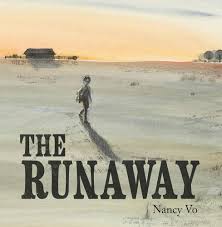The Runaway

The Runaway
He was greeted by the smell of cattle and bread.
The runaway ate a warm loaf with potato soup, then fell into a deep sleep.
In the morning, he went to work on the settlement, striking at stubborn soil.
At night, he dropped onto a bed of straw, too spent to dream.
Time passed. He felt the strength and courage to set out again. But there was no need.
“Annie!’
“Jack…shhhh!”
“Why did you leave me for so long?”
The third book in the Crow trilogy for children, aged 4-8, tells of Jack, a young boy whose mother has just died of cholera. Bereft, he leaves his home, apparently in search of something or somebody. Bravely travelling on despite discomfort and hunger, he is eventually discovered in the woods by two riders. They take him to their settlement where he works for food and gradually rebuilds his strength. As courage and resilience return, he prepares to move on with his journey, but, instead, the object of his search finds him. His sister, Annie, assures him she will never leave him for long but will always come back to him.
Jack is shown as a wistful, vulnerable yet determined boy, desperately searching for what he knows will provide him peace of mind. He seems a lonely, lost soul, navigating the world alone both physically and emotionally. The book satisfactorily conveys his sadness and his satisfaction when he finds his sister.
As with the other two titles in the series, The Outlaw and The Ranger, the strong dramatic artwork captures the time period of the mid-1800s in the Midwest. Bold pictures are executed in ink, watercolour and acetone transfer and use newspaper clippings and posters from the time period. Contrasting colours of grey and yellow reflect the elements of sadness and hope within the story.
While the mystique, understated text and striking illustrations of the first volumes are present, the storyline has less clarity and, at times, is bewildering. With so many parts of the plot being open to interpretation, the reader is left with more questions than answers, the story lost in the unspoken subtleties. The Runaway needs to be shared with an adult in order for young children to understand its significance.
Aileen Wortley is a retired children’s librarian who resides in Toronto, Ontario.
